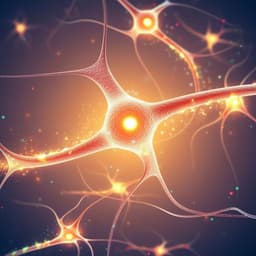
Psychology
The relationship of adverse childhood experiences, hair cortisol, C-reactive protein, and polygenic susceptibility with older adults' psychological distress during the COVID-19 pandemic
K. S. Taylor, A. Steptoe, et al.
This groundbreaking research by Katie S. Taylor, Andrew Steptoe, and Eleonora Iob delves into how childhood experiences and biological markers influence older adults' mental health during the COVID-19 pandemic. The findings reveal a stark connection between adverse childhood experiences and heightened levels of depression, anxiety, and loneliness, emphasizing the lasting impact of early life stressors.
~3 min • Beginner • English
Introduction
The study examines how pre-existing biosocial vulnerabilities—adverse childhood experiences (ACEs), hypothalamic-pituitary-adrenal (HPA) axis activity indexed by hair cortisol, inflammation indexed by C-reactive protein (CRP), and polygenic susceptibility (PGS)—relate to older adults’ psychological distress (depression, anxiety, loneliness) during the COVID-19 pandemic. Grounded in a stress-diathesis framework, the pandemic is conceptualized as a chronic environmental stressor that may amplify the impact of prior adversity and biological/genetic vulnerabilities. Prior research links ACEs to later-life psychopathology and to dysregulated HPA-axis function and inflammation, and suggests genetic factors contribute to risk. The study aims to test whether ACEs, hair cortisol, CRP, and PGS independently predict distress during the pandemic and whether their interactions (especially ACEs with biological/genetic markers) further elevate risk; it also evaluates changes from pre-pandemic to pandemic. Hypotheses: higher ACEs, cortisol, inflammation, and PGS would be associated with greater psychological distress and worsening from pre- to during-pandemic, and ACEs would interact with cortisol, CRP, and PGS to increase risk.
Literature Review
The introduction reviews evidence that: (a) ACEs are consistently associated with poor mental health in later life and during the pandemic; (b) biological mechanisms—HPA-axis dysregulation and systemic inflammation—may mediate adversity-psychopathology links, though findings on cortisol (including hair cortisol, a long-term index) are mixed; (c) ACEs are associated with elevated inflammatory markers in adults, with threat-related adversities showing stronger biological associations; (d) psychiatric disorders are polygenic with small effects across many variants, and PGS can index inherited susceptibility; (e) gene-environment interplay may moderate ACE effects on depression and inflammation; and (f) older adults face age-related increases in cortisol and inflammation and risk of social isolation, making them a key group for examining responses to new stressors like COVID-19.
Methodology
Design and sample: Prospective cohort using the English Longitudinal Study of Ageing (ELSA), a population-based study of adults aged 50+ in England. COVID-19 sub-study assessments occurred in June–July 2020 and November–December 2020. Pre-pandemic mental health was measured at wave 9 (2018/2019). ACEs were assessed at wave 3 (2006/2007). Biomarkers (CRP and hair cortisol) were collected at wave 6 (2012/2013). Inclusion required participation in both COVID-19 assessments and wave 9, completion of the wave 3 life history interview, valid hair cortisol and CRP measures, and genetic data, yielding N=2050.
Outcomes: Depression measured with a 7-item CES-D (modified from CESD-8; range 0–7); binary clinical cut-off defined as ≥4 symptoms. Anxiety measured at COVID waves with GAD-7 (range 0–21); binary cut-off ≥10; pre-pandemic anxiety proxied by ONS anxiety scale at wave 9. Loneliness measured with 3-item UCLA loneliness plus an additional item (range 1–12) at wave 9 and both COVID waves.
Exposures: ACEs (12 types up to age 16) from the wave 3 life history interview, including sexual abuse, physical assault, physical abuse from parents, parental arguments, parental mental illness/substance abuse, parental separation/divorce, low maternal/paternal bonding (PBI-derived; score >3 as low bonding), separation from mother >6 months, parental death, foster care/adoption, institutionalization. Main exposure: cumulative ACE count categorized as 0, 1, or ≥2 in descriptive/individual models; continuous ACE count used in mutually adjusted and interaction models. CRP: high-sensitivity plasma CRP (wave 6); binary high CRP defined as ≥3 mg/L. Hair cortisol: 3 cm scalp-proximal hair segment (wave 6) assayed by HPLC-MS/MS; values log-transformed due to skew. PGS: polygenic scores for major depressive disorder (MDD-PGS), anxiety (ANXIETY-PGS), and loneliness (LONE-PGS) constructed from large GWAS meta-analyses using PLINK/PRSice with p-value threshold=1; adjusted for 10 ancestry principal components.
Covariates: Adult sociodemographics (age, gender, partnership, living alone, wealth tertiles), medication use (anti-inflammatory/antihypertensive drugs, steroids), childhood socioeconomic factors (overcrowding, number of books, financial hardship, parental unemployment), hair characteristics (dyed, color, season, lab phase), and pre-pandemic outcome measures; ancestry PCs (for PGS models). Sensitivity models additionally adjusted for lifestyle factors (physical activity, alcohol, smoking, BMI), limiting long-standing illness, and COVID-19-related worries (financial insecurity, perceived risk, bereavement, infection).
Statistical analysis: Conducted in R. Hair cortisol log-transformed. Computed average COVID-19 score across the two COVID-19 assessments for each outcome. Step 1: Individual logistic (depression, anxiety) and linear (loneliness) regressions testing each exposure-outcome association adjusting for relevant covariates and pre-pandemic outcome. Step 2: Mutually adjusted models including ACEs (continuous), hair cortisol, CRP, and the respective PGS with all relevant covariates; tested interactions between ACEs and each of hair cortisol, CRP, and PGS. Step 3: Mixed-effects models to assess change from pre-pandemic to during-pandemic using a binary period indicator, with interactions of period by each exposure for depression (logistic) and loneliness (linear). No mixed-effects for anxiety due to differing pre-pandemic measure. Sensitivity analyses included: adding lifestyle and illness covariates; testing ACE dimensions (threat, household dysfunction, bonding, loss); excluding CRP>10 mg/L; using continuous CRP; repeating models with pre-pandemic outcomes; using continuous depression/anxiety; adding COVID-19-related worries; Benjamini-Hochberg FDR correction; subgroup comparisons of included vs excluded participants.
Key Findings
Descriptives: N=2050; mean age 75.15 (SD 6.51); 34% male; 51.7% had 0 ACEs, 22.3% had 1, 26.0% had ≥2; 24.7% had high CRP (≥3 mg/L); mean hair cortisol (log) 2.13 (SD 1.50). Depression prevalence rose from 7.7% pre-pandemic to 15.1% and 17.2% in COVID waves 1 and 2; anxiety 6.1% and 7.1% in COVID waves 1 and 2; loneliness increased from ~5.16 pre-pandemic to ~5.45 and ~5.51 during COVID.
Individual associations (adjusted for pre-pandemic outcomes): ACEs were associated with higher depression (1 ACE OR=1.82 [1.24,2.65]; ≥2 ACEs OR=2.55 [1.81,3.59]), anxiety (1 ACE OR=1.79 [1.04,3.05]; ≥2 ACEs OR=1.84 [1.13,3.01]), and loneliness (≥2 ACEs b=0.28 [0.14,0.42]). Hair cortisol associated with depression (OR per 1-unit log increase=1.15 [1.04,1.26]). High CRP associated with higher loneliness (b=0.16 [0.03,0.30]).
Mutually adjusted models: ACEs (continuous) and hair cortisol remained associated with depression (ACEs OR=1.22 [1.11,1.35]; hair cortisol OR=1.14 [1.03,1.26]). ACEs and high CRP remained associated with higher loneliness (ACEs b=0.09 [0.05,0.14]; high CRP b=0.15 [0.01,0.29]). ACEs were no longer significantly associated with anxiety after mutual adjustment. PGS were not significantly associated with respective outcomes during the pandemic.
Interactions: Significant ACEs × hair cortisol interactions indicated stronger associations of hair cortisol with higher depression (interaction OR=1.07 [1.00,1.14]), anxiety (interaction OR=1.17 [1.06,1.28]), and loneliness (interaction b=0.04 [0.01,0.07]) among those with more ACEs. No ACEs × CRP or ACEs × PGS interactions were found.
Mixed-effects models (change from pre- to during-pandemic): High CRP predicted greater increases in loneliness (interaction b=0.23 [0.10,0.37]). Having ≥2 ACEs predicted greater increases in depression (interaction OR=2.09 [1.10,3.98]). Higher hair cortisol predicted greater increases in depression across time (interaction OR=1.84 [1.41,2.41]).
Sensitivity and robustness: After FDR correction, most findings remained, but ACEs–anxiety and CRP–loneliness associations in regression models, and ACEs×cortisol interactions for depression and loneliness, attenuated (interaction for anxiety remained). Using continuous CRP attenuated CRP–loneliness and revealed a CRP–anxiety association; using continuous depression/anxiety altered some associations (e.g., cortisol–depression attenuated). PGS for depression and anxiety predicted pre-pandemic distress but not pandemic responses. Excluding CRP>10 mg/L did not change results. Threat-related ACEs were most consistently related to distress. Sample selection differences suggest potential selection bias.
Discussion
Findings support a stress-diathesis model in which pre-existing psychosocial and biological vulnerabilities shape psychological responses to the pandemic. ACEs were consistently linked to higher depression, anxiety, and loneliness during COVID-19, and to greater worsening in depression, independent of pre-pandemic distress, suggesting the pandemic accentuated the psychological impact of early adversity. Elevated hair cortisol, a marker of HPA-axis activity, was associated with higher depression risk and greater worsening of depression, with stronger effects among those with more ACEs, indicating HPA-axis dysregulation may be a key mechanism linking early adversity to later stress reactivity and psychopathology. Elevated CRP predicted greater increases in loneliness, consistent with a role for inflammation in social-affective processes and stress reactivity. In contrast, PGS for depression, anxiety, and loneliness did not predict pandemic responses in this older cohort, though they were associated with pre-pandemic distress, suggesting that genetic susceptibility may influence baseline mental health more than responses to acute societal stressors in late life. Overall, results highlight enduring biosocial vulnerabilities that predispose older adults to worse mental health under new environmental stressors and implicate HPA-axis and inflammatory pathways in later-life psychological distress.
Conclusion
This study shows that adverse childhood experiences are a reliable marker of vulnerability to psychological distress among older adults during the COVID-19 pandemic, with additional contributions from dysregulated HPA-axis activity and inflammation. Interactions between ACEs and hair cortisol underscore the importance of HPA-axis mechanisms in embedding early adversity and shaping responses to later stressors. While polygenic susceptibility influenced pre-pandemic mental health, it did not predict pandemic responses in this cohort. The findings support targeting older adults with pre-existing biopsychosocial risks for preventive and therapeutic interventions, including psychosocial support to mitigate the effects of ACEs and potential biological interventions addressing HPA-axis and inflammatory pathways. Future research should use longitudinal designs that consider age, type and timing of adversity, broader inflammatory markers (e.g., IL-6), and optimized cortisol measurement to refine understanding of biological pathways from early adversity to psychopathology.
Limitations
Key limitations include: limited ethnic diversity and generation of PGS only for European-ancestry participants, reducing generalizability; use of an older anxiety GWAS for PGS and a p-threshold of 1, potentially adding noise; possible selection bias due to exclusion of participants without biomarker/genetic or ACEs data and observed demographic differences between included and excluded samples; reliance on self-reported psychological distress and retrospective ACEs, with potential recall and social desirability bias and known discrepancies with prospective measures; exposures (ACEs, CRP, hair cortisol) were measured years before the pandemic (14 and 8 years, respectively), which may affect interpretation; reduced power due to analytic sample size; some associations depended on variable operationalization (binary vs continuous), and several findings attenuated after FDR correction, questioning robustness; inability to fully disentangle age-related changes from pandemic-specific effects.
Related Publications
Explore these studies to deepen your understanding of the subject.







